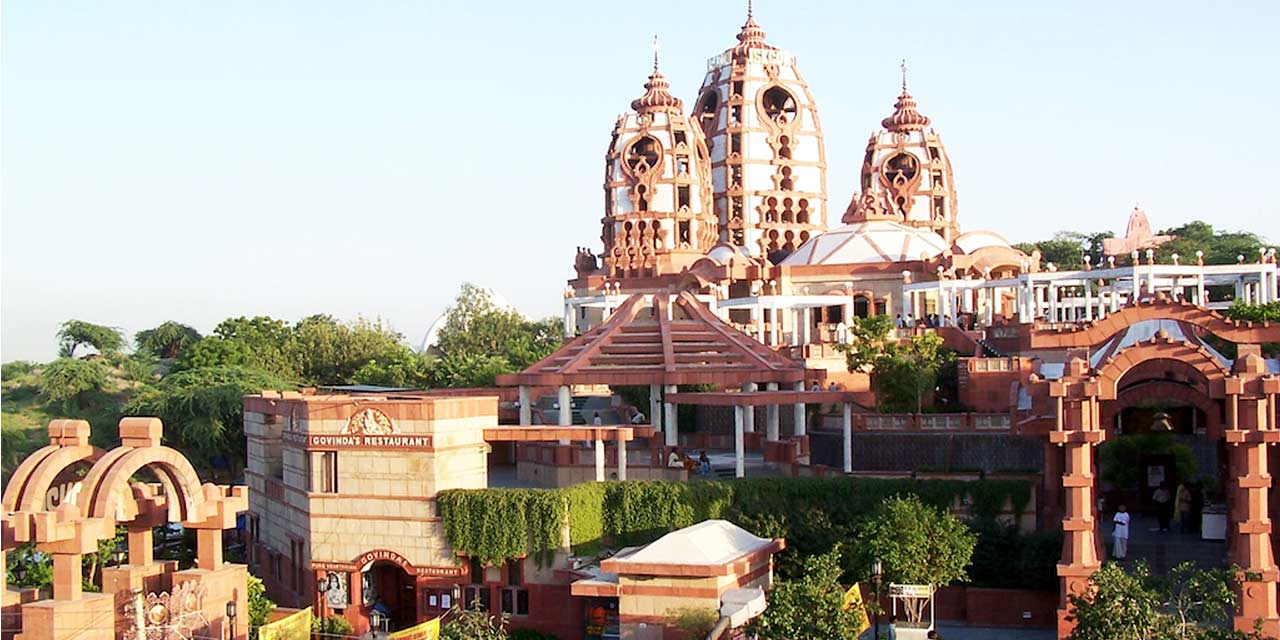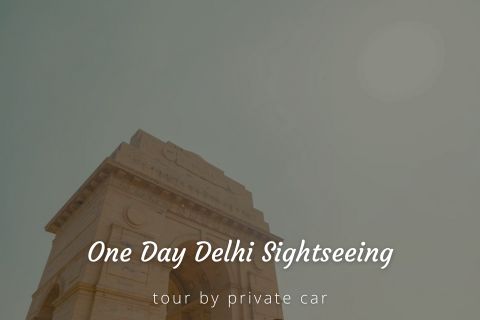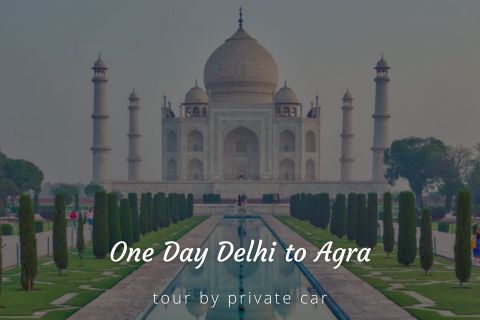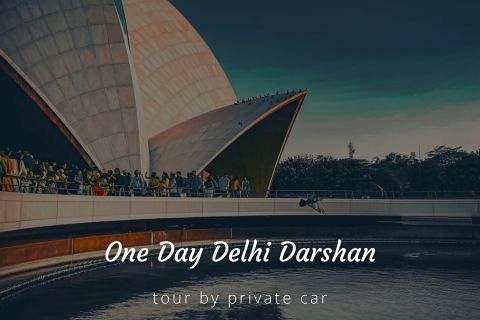
ISKCON Temple Delhi Entry Fee
- No entry fee
ISKCON Temple Delhi Phone
+91 93102 69713
Rating:  | 5 stars, of total 59 reviews
| 5 stars, of total 59 reviews
ISKCON Temple Delhi Address: Hare Krishna Hill, Sant Nagar, Main Road, East of Kailash, Sant Nagar, East of Kailash, New Delhi, Delhi, 110065, India
Delhi City Tour Packages
ISKCON Temple Delhi Timings
| Day | Timing |
|---|---|
| Monday | 4:30 am – 1:00 pm 4:00 pm – 9:00 pm |
| Tuesday | 4:30 am – 1:00 pm 4:00 pm – 9:00 pm |
| Wednesday | 4:30 am – 1:00 pm 4:00 pm – 9:00 pm |
| Thursday | 4:30 am – 1:00 pm 4:00 pm – 9:00 pm |
| Friday | 4:30 am – 1:00 pm 4:00 pm – 9:00 pm |
| Saturday | 4:30 am – 1:00 pm 4:00 pm – 9:00 pm |
| Sunday | 4:30 am – 1:00 pm 4:00 pm – 9:00 pm |
The ISKCON Temple in Delhi, also known as Sri Sri Radha Parthasarathi Mandir, is a Hindu temple of the Vaishnava sect dedicated to the worship of the deities of Krishna and Radharani. It is one of the largest temple complexes in the entire country.
Apart from idol worship arrangements, there is a Vedic cultural centre in the premises, with attractions such as animatronics, art galleries, and more. The cultural centre is also home to the largest printed version of the Bhagavad Gita, the Hindu religious scriptures.
With a library, a bookstore, a restaurant and plenty of other facilities, ISKCON Temple Delhi will keep you occupied and entertained for sure! Here is all the information you will need before you visit this temple.
ISKCON Temple Timings, Entry Fee & Aarti Schedule
The ISKCON Temple is open on all days of the week. The temple hall opens with the Mangala Arati which is a ritual performed early in the morning at 4:30. It stays open until 9 in the night, although the main hall remains closed between 1 and 4 in the afternoon.
If you are looking for free things to see in Delhi, then you will be happy to note that this ISKCON Temple’s entry fee is nil. However, they do have provisions to make donations, whether you would like to pay physically via cash, check or demand draft, or virtually through their website’s payment gateway.
There are several aratis that are conducted throughout the day in this temple. You can choose the one you wish to watch, and time your visit accordingly. Darshan Arati happens at 7 AM, Guru Puja at 7:30 AM, Raj Bhog Arati at 12:30 PM, Usthapana Arati at 4:15 PM, Sandhya (dusk) Arati at 6:30 PM, and finally, Sayana Arati at 8:30 PM.
Apart from ritualistic worship of the deities, the temple also organizes Japa (Mantra) Meditation at 5:15 AM wherein verses from the Srimad Bhagavat Purana (the book which is considered as the sacred text of the Hindus) are chanted repeatedly. Also, at 8 AM and 8 PM every day, a discourse on Srimad Bhagavatam is given.
Image Gallery of ISKCON Temple Delhi
What is ISKCON?
ISKCON is an abbreviation for International Society for Krishna Consciousness. This spiritual institution is part of the Gaudiya-Vaishnava denomination of Hinduism. Interestingly, even though the Hindu culture believes in polytheism (the presences of innumerable gods), Gaudiya-Vaishnava is monotheistic. It primarily believes in worshipping the deity of Krishna. The context is derived from the Bhagavad Gita, accorded the place of scriptures, which was written in Sanskrit many centuries ago.
The ISKCON brand was founded by A.C. Bhaktivedanta Swami Prabhupada in July 1966 in New York City. The Krishna Consciousness Movement took off, and over a few decades, 108 ISKCON temples sprang up across the world while Srila Prabhupada still lived. In his days, this movement had gathered about 10,000 followers worldwide.
History Behind the ISKCON Temple
Even though the ISKCON movement is much older, the temple in Delhi opened many years later, on the 5th of April in 1998. It was designed and built by Padma Shri Achyut Purushottam Kanvinde. The architect earned his title of Padma Shri in 1974.
The construction of the temple was in cooperation with The Hinduja Foundation with an initial target date of December 1995. The total cost of the project was 12 crore rupees, and it was mainly funded by Delhi and the rest of India.
Architecture of ISKCON Temple
ISKCON Temple Delhi’s architecture is mainly of the Hindu Temple style, with elements of Brutalist architecture and functionalist approaches, which was the trademark of the architect, Padma Shri Achyut Purushottam Kanvinde.
The entire ISKCON complex in Delhi consists of six major sections:
1. The Temple: The main temple is situated atop the Hare Krishna Hills, with towers having latticed walls. Construction materials used for the temple are marble, wood and carved stone. It is here that the main idols are established and worshipped through rituals and aratis throughout the day.
2. The Centre for Vedic Studies: This section has various halls for seminars, classes and conferences on Vedic philosophy. It also houses a library, called the Library of Vedic Research. The collection of books include tomes on Vedic literature in an assortment of languages of India and the rest of the world, apart from English.
3. The Centre for Vedic Performing Arts: This is an open-air amphitheatre facing the temple. The space is dedicated for traditional musical and dance performances.
4. The Museum of Vedic Culture: This museum, also called the Glory of India Vedic Cultural Centre, helps visitors learn about Hindu scriptures. A variety of multimedia technologies are used for the presentation of these ancient texts.
The Bhagavad Gita Animatronics uses narration, drama, laser effects and projections to show the five major concepts of Bhagavad Gita, Yoga and the three modes of nature. The Mahabharata Experience is a light and sound show depicting the story of the epic, Mahabharata.
The Ramayana Art Gallery displays a collection of dozens of oil paintings by ISKCON members from various parts of the world. Finally, the Bhagavat Puran Exhibit visually presents the Vaishnava customs.
5. Krishna Jayanti Park: This park is inspired by the fables of Krishna’s early days when he frolicked with milkmaids in gardens and groves. The Krishna Jayanti Park has ponds and waterfalls which add to the tranquillity of the place.
6. The Ashram: The Ashram is a residential complex where Krishna devotees can stay and focus on studying and teaching Vedic literature and lifestyle.
Things to do at ISKCON Temple
The ISKCON Temple in Delhi is not just another boring temple with statues. There are plenty of activities to be pursued here and a lot of things you can check out:
1. Walk around the Hare Krishna Hill on which the temple stands.
2. Attend one of the multiple aratis that are conducted inside the main temple.
3. Explore the Temple Bookshop and buy one of their Vedic publications.
4. Spend some time inside the Bhaktivedanta Library and take a look at the largest printed Gita in the world. Apart from that book, you can flip through over 2000 books penned by various people from across the world. The collection here is not only of spiritual books but also multimedia videos and documentaries on spirituality.
5. Eat at the in-house restaurant, Govinda’s. This eatery serves pure vegetarian food which is first offered to the deity of Krishna before being served at the restaurant. They serve a total of 18 items each for lunches and dinners. In addition to being vegetarian, the food is also sattvik, which means that onion and garlic are not used in any of the preparations. Lunch begins at noon and lasts until 3:30 PM, whereas dinner is served from 7 PM to 10 PM.
6. If you do not get a chance to visit inside the temple, you can watch a live streaming of the proceedings right on their website!
7. Be enthralled by the Vedic Cultural Museum which has a combination of dioramas, exhibits and interactive experiences. There is particular focus on the epics of Ramayana and Mahabharata.
8. Attend the Bhagavad Gita Experience which uses light effects , robots and dramatic narration to present the teachings of the Bhagavad Gita.
9. Watch India’s only Quadrascope as you enjoy an animated video on Vedic teachings projected on a larger-than-life video globe.
10. Appreciate the works of art at the Ramayana Art Gallery. The paintings mostly depict Rama and his wife Sita, the two central characters in the Hindu epic of Ramayana.
11. If visiting during Ramanavami, the birthday of Rama, you can watch a drama enacted in front of you, and also enjoy a feast.
12. During the annual Jagannath Rath Yatra in October or November, a hand-drawn cart is paraded and the ritualistic chappan bhog (offering of 56 food items) is made to the idol.
13. At the time of Nauka Vihar (Boat Festival), the Kailya Krishna pond is decorated with flowers and the statues of Krishna and his love interest, Radha, are taken for a boat ride amidst chanting by the devotees.
14. The birth of the deity of Krishna is celebrated with pomp and posh during the festival of Janmashtami, and it’s a 12-day affair at the ISKCON Temple. A procession is also held outside the temple, called the shobha yatra.
15. If you are a foodie or interested in cooking, you can join one of their programmes which let you participate in the process of making the prasad (sacred food) which you can also help distribute, and finally, eat.
16. ISKCON Delhi also has a youth forum which organizes a lot of interesting activities round the year. Keep an eye on their events calendar to be a part of their camps, youth fests, seminars and workshops.
Interesting Facts About ISKCON Temple
The ISKCON Temple in Delhi has quite a few things about it which will surprise you. Here are a few of them:
1. The largest religious book in the world is the 'Astounding Bhagavad Gita' which was printed in Italy. This book was inaugurated on 26th February 2019 by the Prime Minister of India, Narendra Modi. The book weighs 800 kg and is 2.8 metres in length.
2. This temple was opened on 5th April 1998 by Atal Bihari Vajpayee, the Prime Minister of India at the time. This date was almost 3 years behind the originally planned date.
3. The materials used in the construction of the temple measured 880 tons of steel, 5,500 tons of cement, 25,000 square feet of marble, 75,000 square feet of stone, 260,000 cubic feet of stone chips and 2,000 cubic feet of wood.
4. A mere 250 construction workers were employed for this massive project.
5. A total of 12 crore rupees was spent on the entire construction project. A lot of this was received in donations from ISKCON devotees around the world.
6. One of the key practices of the Krishna Consciousness movement is to chant Krishna’s names. This practice is called ‘Harinam Sankirtan’. Groups of white or saffron clad people are often seen repeating the phrase ‘Hare Rama Hare Krishna’ while they appear to go in a state of trance and dance as they also play certain musical instruments.
7. The founder of ISKCON had gone to New York via Boston on a freight ship to establish this movement there. He reached there with only USD 7 in his pocket. Gradually, with the help of new friends he made there, he was able to rent a room for himself and a shop where the organization was officially registered.
Things to Keep in Mind While Visiting ISKCON Temple
Since this is a place of religion and spiritualism, there are certain things you must be mindful of:
1. You are advised to dress modestly, particularly covering your shoulders and knees. This effectively means, no shorts or short skirts or tops that are revealing.
2. Photography is not allowed inside the temple. However, you can use your camera to take pictures of the hills and the lake.
3. If you wish to stay at the ISKCON Ashram or guest house, you will have to make arrangements in advance.
4. The organization emphasizes that you do not need to change your religion to follow the philosophy of ISKCON. You can be from any religion in the world and still become a Krishna devotee.
5. If you are travelling with a group, you can attend some of the specially designed seminars as per your group type. The seminars and all other programs are designed around the teachings of the Vedas.
6. There is adequate provision of restrooms, should you have any requirement for bio-breaks.
7. Even though it is free to enter here, the institution bears the cost of hosting you, especially if you decide to take their free bhog-meals on special occasions. For this, they often ask for voluntary donations.
Places to Visit Near ISKCON Temple
If you’re travelling from a different city and would like to make the most of your time in Delhi after visiting the ISKCON Temple, you can consider visiting some of the attractions nearby:
1. Lotus Temple: Located a little more than a kilometre away from ISKCON, the Lotus Temple beckons with its lovely architecture. Shaped like a lotus, this temple is also called the Bahá'í House of Worship. This beautiful building is surrounded by 9 ponds along the 9 sides of its lotus structure, making it appear very soothing to the eye.
The overall form of this building is of a lotus flower about to blossom. Each of the 9 sides of the Bahá'í House of Worship has 3 petal-like structures. And these are made of white marble. The sanctum welcomes people of all religions to sit inside and meditate or pray. The temple is open from 9 AM to 6 PM on all days except Mondays.
2. Astha Kunj Park: A 10-minute walk from the temple, this park has a seasonal lake (which fills up in the monsoon) and an open-air gym. The greenery ensures a good chance of birding. There’s also a jogging track for fitness enthusiasts. The park is open from 4 AM to 9 PM on all days of the week.
3. Shri Kalka Ji Temple: 15 minutes away from ISKCON, Shri Kalka Ji Temple is an 18th century shrine dedicated to the Hindu deity of Kali. It is believed that those who worship here have their wishes fulfilled.
This is also considered as one of the Siddha Peeth regions where the lower lip of the female goddess fell. It is for this reason that many believe that the place grants all the wishes of true devotees.
4. Ashokan Edict: Half a kilometre from the temple, one of several edicts erected by the 3rd century BC emperor of India, Ashoka, can be found. The rock has inscriptions on Buddhist teachings written in the ancient Prakrit language in the Brahmi script.
There are several other edicts in Delhi, some transported in from their original excavation sites where the Mauryan Empire was present. Buddhism itself was promoted by Ashoka after his realization of the devastation he had caused during his final war.
5. Durga Bari Mandir: If you have a car, do a 10-minute drive to Durga Bari Mandir which is a temple built for the purpose of worshipping the Hindu goddess Durga. The temple is only a part of the complex, the other being a guest house which is made available to visitors upon prior booking.
Managed by a Bengali committee, the temple conducts evening arati and has special programs during the festival of Durga Puja. The ritualistic bhog (sacred food) is also served during the final days of the festival.
6. Hauz Khas Forest: Located 5 km away, the drive to this forest takes about 20 minutes. Apart from a pond and several walking tracks, the Hauz Khas Forest also houses the Ruins of Siri Fort. In the monsoon, it is possible to sight peacocks in this area.
7. Doctor Zakir Hussain Museum: Open from 8 AM until 5 PM every day, except Sundays, this museum exhibits memorabilia of the 3rd President of India, Dr. Zakir Hussain. This is a free attraction as there is no fee to enter inside. The place can be reached in less than 10 minutes via car as it’s only 4 km away from ISKCON.
Dr. Hussain extensively promoted the cause of education across India, and also received a lot of awards in his lifetime. The museum, along with all the objects associated with the President, also contains his tomb.
8. Moth ki Masjid: This 16th century mosque lies at a distance of almost 6 km from the temple. Making it possible to arrive here in 12 minutes or so. This site of Islamic worship is rather well preserved under the ASI (Archaeological Survey of India).
Part of the Masjid Moth village, the mosque displays exemplary examples of Mughal architecture, with intricate carvings and towers.
9. Kale Khan Ka Makbara: About 6 km from the ISKCON Temple, this mausoleum is also called Kale Khan ka Gumbad. The place contains the tomb of Mubarak Khan, and was built in 1481 AD. Mostly deserted, it is advisable to visit here in the daytime when there is sufficient natural light.
How to Reach ISKCON Temple
Delhi’s ISKCON Temple is located in East of Kailash, and there are a number of ways to get here, even though the position of the temple atop a hill means that your final leg will have to be covered on foot or by car:
Via Metro: Delhi Metro is a super convenient way to travel in an air-conditioned and safe mode without shelling out a bomb. The ISKCON Temple area is serviced by the Violet Line, and you can plan your travel so that you reach the Nehru Place Station or the Kailash Colony Station. The nearest metro station to ISKCON temple is Nehru Place Station, only a few minutes’ walk away.
City Buses: The closest bus stop to the temple is Mahalakshmi Layout Entrance, 2 km away. You can take a bus for a cheaper way to get here, especially from the railway stations. Hazrat Nizamuddin station happens to be the closest railway station from the temple, at a distance of 4.5 km. The next nearest railway station is the New Delhi Railway Station.
Arriving from the Airport: If travelling from the Indira Gandhi International Airport, take the Outer Ring Road towards Greater Kailash. You should be able to cover the 17 odd kilometres in 45 minutes. The condition of roads in New Delhi is astonishingly good, and the driving experience can be quite nice.
An alternative route is to take the Mahatma Gandhi Marg, but this one is 21 km long, requiring almost an hour’s drive. If you don’t wish to drive or rent a cab, you can try the metro. The airport falls on the Orange Line though, and you’ll have to change over to the Violet Line to get to ISKCON Delhi.
For a hassle free commutation within the city, you can also opt for a private cab from top car rental companies in Delhi and visit all the popular sightseeing places of Delhi in a relaxed manner.
For your convenience, we at Delhi Tourism, a division of Holidays DNA have designed Delhi Tour packages keeping your budget in mind. You can have a fun filled trip to this happening city in the comfort of a private cab that is available exclusively for you during the entire duration of your trip. Fill out the Contact Us form to know more about us!



